Gore's Management Approach: A Unique System of Lattice Structure
VerifiedAdded on 2023/06/04
|15
|3620
|331
AI Summary
Bill Gore developed a unique management approach based on lattice structure that prioritizes communication and cooperation over hierarchy. This approach encourages innovation and creativity, and values individual contributions. The system has advantages such as a strong company culture, belief in the individual, and long-term goals. However, it also has disadvantages such as the need for a shift in values and attitudes, and a potential hurdle for executive management. The transferability of this approach is also discussed.
Contribute Materials
Your contribution can guide someone’s learning journey. Share your
documents today.
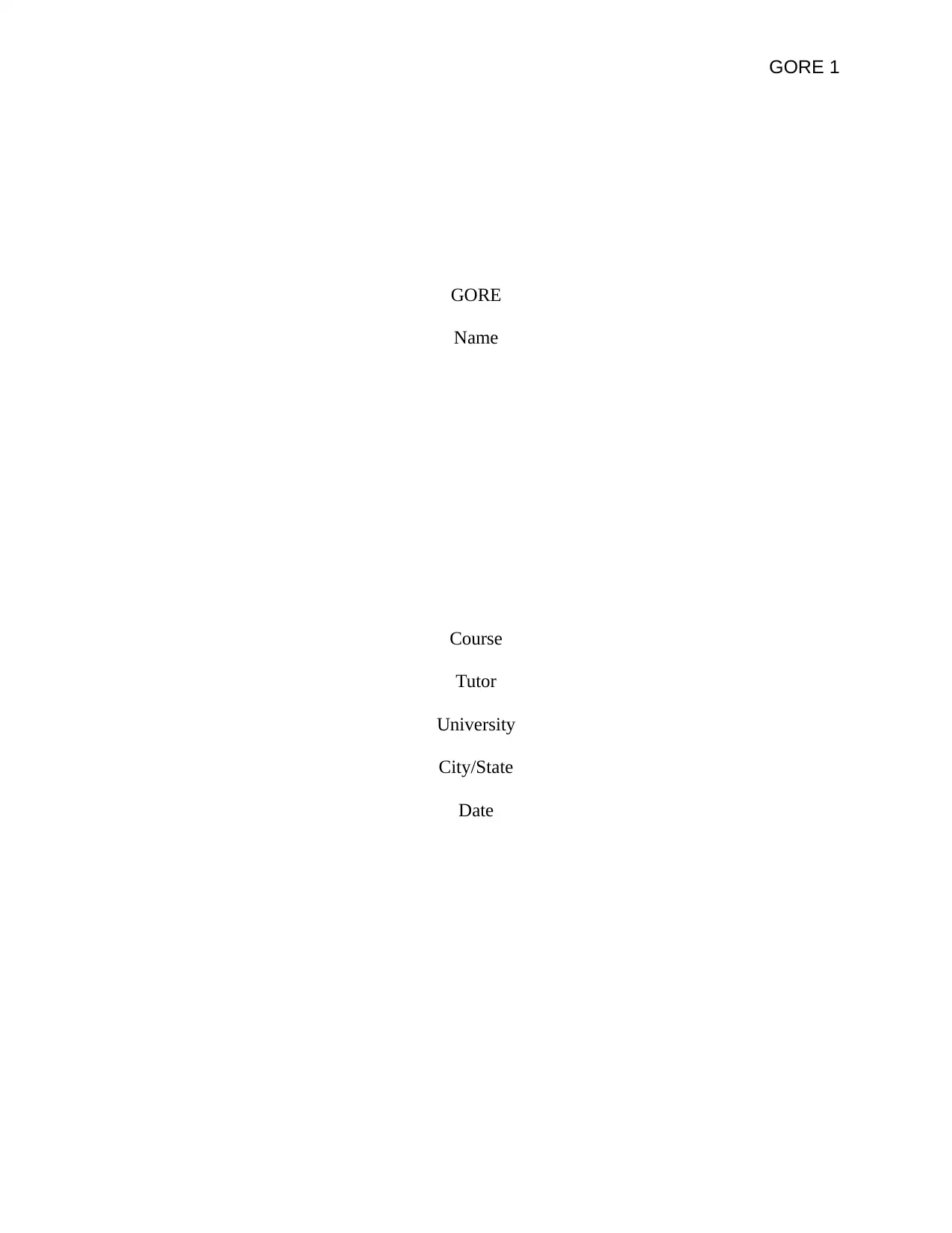
GORE 1
GORE
Name
Course
Tutor
University
City/State
Date
GORE
Name
Course
Tutor
University
City/State
Date
Secure Best Marks with AI Grader
Need help grading? Try our AI Grader for instant feedback on your assignments.
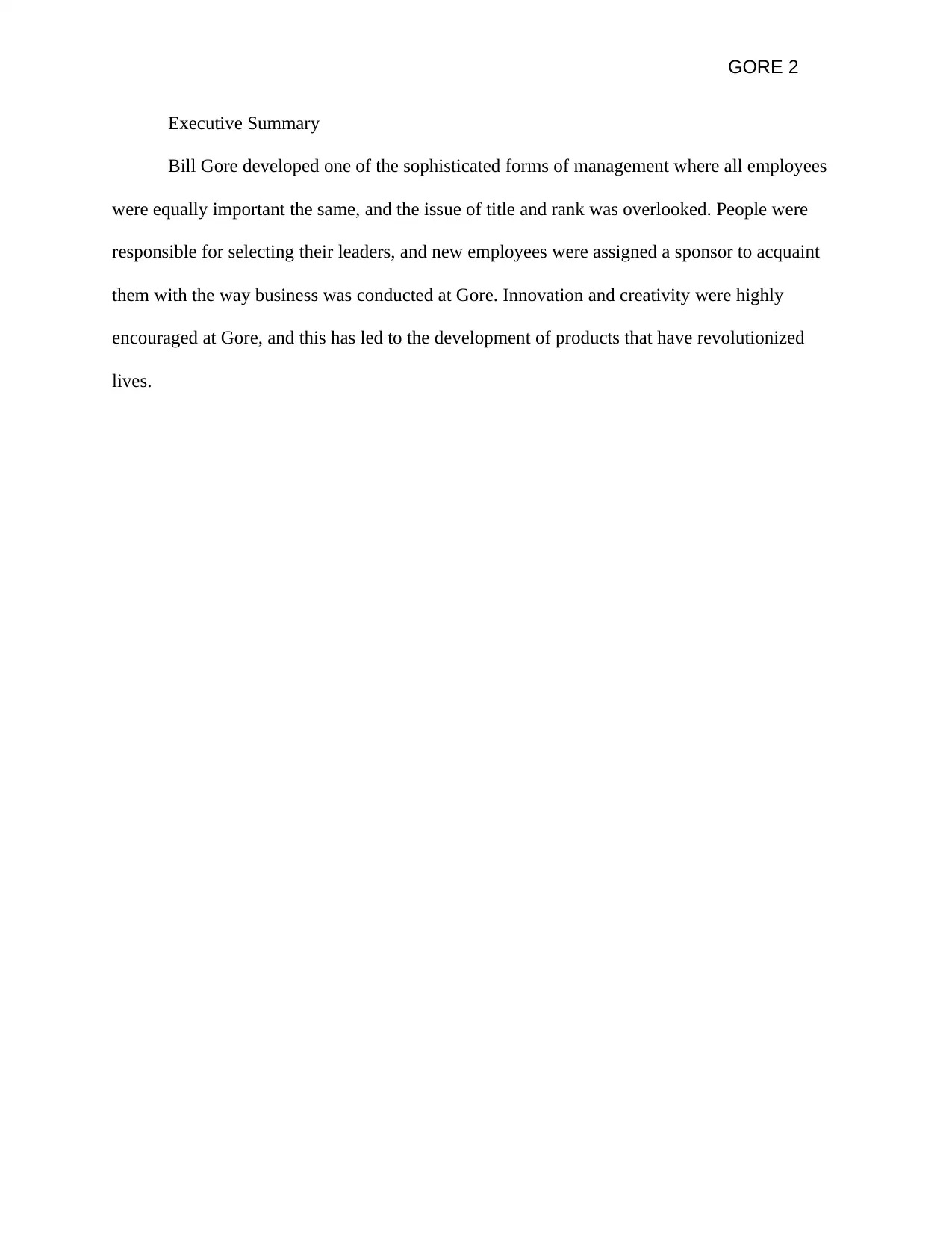
GORE 2
Executive Summary
Bill Gore developed one of the sophisticated forms of management where all employees
were equally important the same, and the issue of title and rank was overlooked. People were
responsible for selecting their leaders, and new employees were assigned a sponsor to acquaint
them with the way business was conducted at Gore. Innovation and creativity were highly
encouraged at Gore, and this has led to the development of products that have revolutionized
lives.
Executive Summary
Bill Gore developed one of the sophisticated forms of management where all employees
were equally important the same, and the issue of title and rank was overlooked. People were
responsible for selecting their leaders, and new employees were assigned a sponsor to acquaint
them with the way business was conducted at Gore. Innovation and creativity were highly
encouraged at Gore, and this has led to the development of products that have revolutionized
lives.
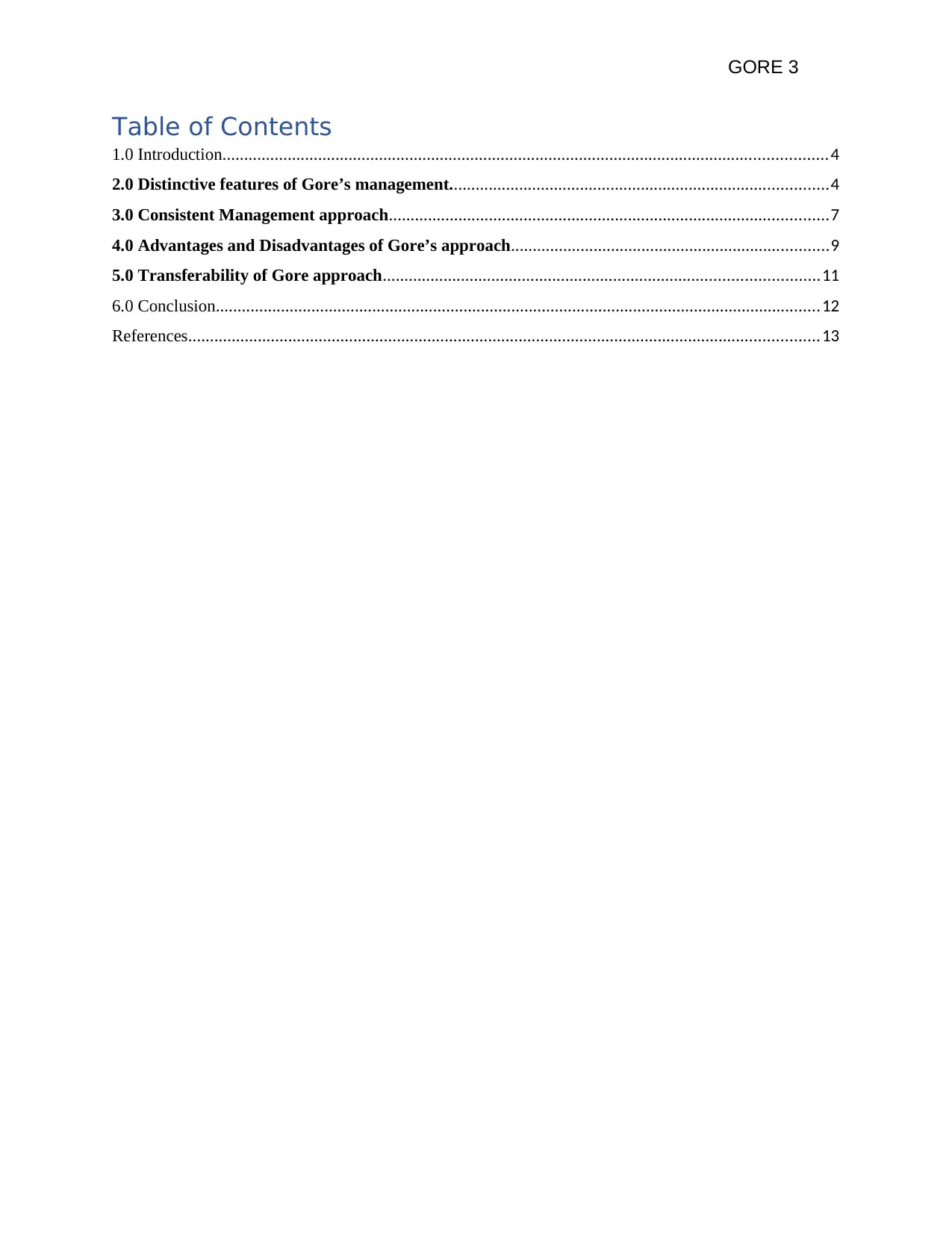
GORE 3
Table of Contents
1.0 Introduction...........................................................................................................................................4
2.0 Distinctive features of Gore’s management.......................................................................................4
3.0 Consistent Management approach.....................................................................................................7
4.0 Advantages and Disadvantages of Gore’s approach.........................................................................9
5.0 Transferability of Gore approach....................................................................................................11
6.0 Conclusion...........................................................................................................................................12
References.................................................................................................................................................13
Table of Contents
1.0 Introduction...........................................................................................................................................4
2.0 Distinctive features of Gore’s management.......................................................................................4
3.0 Consistent Management approach.....................................................................................................7
4.0 Advantages and Disadvantages of Gore’s approach.........................................................................9
5.0 Transferability of Gore approach....................................................................................................11
6.0 Conclusion...........................................................................................................................................12
References.................................................................................................................................................13
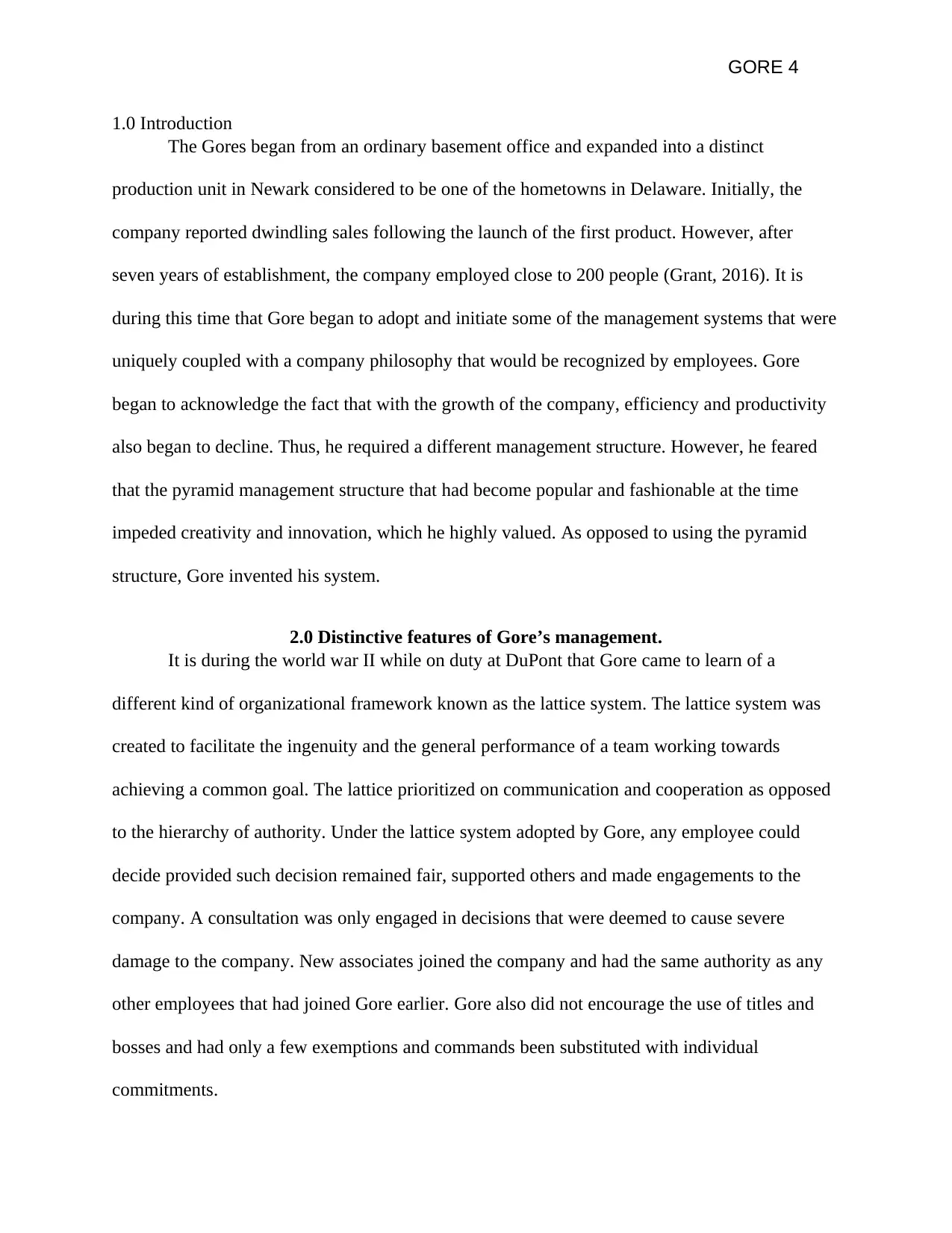
GORE 4
1.0 Introduction
The Gores began from an ordinary basement office and expanded into a distinct
production unit in Newark considered to be one of the hometowns in Delaware. Initially, the
company reported dwindling sales following the launch of the first product. However, after
seven years of establishment, the company employed close to 200 people (Grant, 2016). It is
during this time that Gore began to adopt and initiate some of the management systems that were
uniquely coupled with a company philosophy that would be recognized by employees. Gore
began to acknowledge the fact that with the growth of the company, efficiency and productivity
also began to decline. Thus, he required a different management structure. However, he feared
that the pyramid management structure that had become popular and fashionable at the time
impeded creativity and innovation, which he highly valued. As opposed to using the pyramid
structure, Gore invented his system.
2.0 Distinctive features of Gore’s management.
It is during the world war II while on duty at DuPont that Gore came to learn of a
different kind of organizational framework known as the lattice system. The lattice system was
created to facilitate the ingenuity and the general performance of a team working towards
achieving a common goal. The lattice prioritized on communication and cooperation as opposed
to the hierarchy of authority. Under the lattice system adopted by Gore, any employee could
decide provided such decision remained fair, supported others and made engagements to the
company. A consultation was only engaged in decisions that were deemed to cause severe
damage to the company. New associates joined the company and had the same authority as any
other employees that had joined Gore earlier. Gore also did not encourage the use of titles and
bosses and had only a few exemptions and commands been substituted with individual
commitments.
1.0 Introduction
The Gores began from an ordinary basement office and expanded into a distinct
production unit in Newark considered to be one of the hometowns in Delaware. Initially, the
company reported dwindling sales following the launch of the first product. However, after
seven years of establishment, the company employed close to 200 people (Grant, 2016). It is
during this time that Gore began to adopt and initiate some of the management systems that were
uniquely coupled with a company philosophy that would be recognized by employees. Gore
began to acknowledge the fact that with the growth of the company, efficiency and productivity
also began to decline. Thus, he required a different management structure. However, he feared
that the pyramid management structure that had become popular and fashionable at the time
impeded creativity and innovation, which he highly valued. As opposed to using the pyramid
structure, Gore invented his system.
2.0 Distinctive features of Gore’s management.
It is during the world war II while on duty at DuPont that Gore came to learn of a
different kind of organizational framework known as the lattice system. The lattice system was
created to facilitate the ingenuity and the general performance of a team working towards
achieving a common goal. The lattice prioritized on communication and cooperation as opposed
to the hierarchy of authority. Under the lattice system adopted by Gore, any employee could
decide provided such decision remained fair, supported others and made engagements to the
company. A consultation was only engaged in decisions that were deemed to cause severe
damage to the company. New associates joined the company and had the same authority as any
other employees that had joined Gore earlier. Gore also did not encourage the use of titles and
bosses and had only a few exemptions and commands been substituted with individual
commitments.
Secure Best Marks with AI Grader
Need help grading? Try our AI Grader for instant feedback on your assignments.
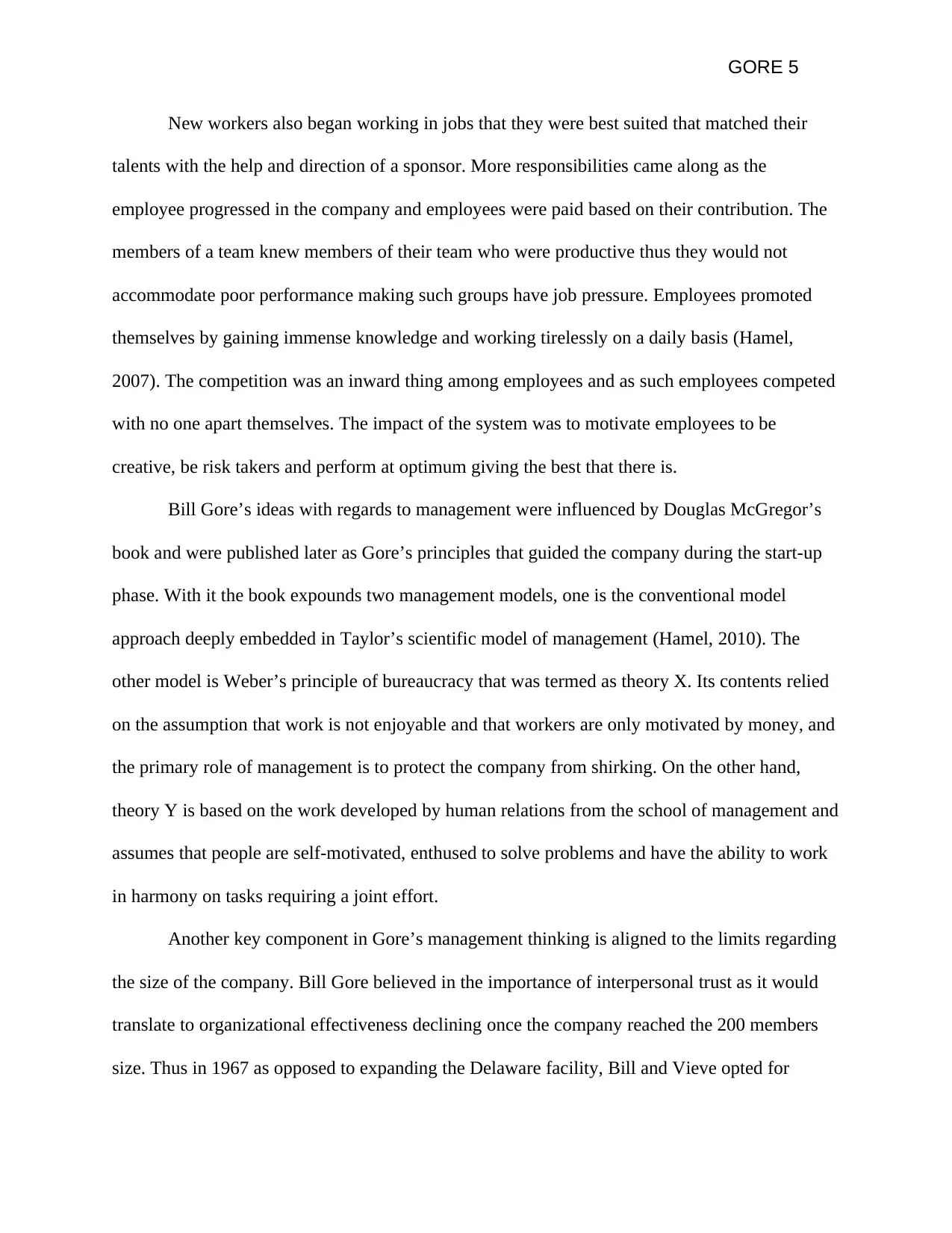
GORE 5
New workers also began working in jobs that they were best suited that matched their
talents with the help and direction of a sponsor. More responsibilities came along as the
employee progressed in the company and employees were paid based on their contribution. The
members of a team knew members of their team who were productive thus they would not
accommodate poor performance making such groups have job pressure. Employees promoted
themselves by gaining immense knowledge and working tirelessly on a daily basis (Hamel,
2007). The competition was an inward thing among employees and as such employees competed
with no one apart themselves. The impact of the system was to motivate employees to be
creative, be risk takers and perform at optimum giving the best that there is.
Bill Gore’s ideas with regards to management were influenced by Douglas McGregor’s
book and were published later as Gore’s principles that guided the company during the start-up
phase. With it the book expounds two management models, one is the conventional model
approach deeply embedded in Taylor’s scientific model of management (Hamel, 2010). The
other model is Weber’s principle of bureaucracy that was termed as theory X. Its contents relied
on the assumption that work is not enjoyable and that workers are only motivated by money, and
the primary role of management is to protect the company from shirking. On the other hand,
theory Y is based on the work developed by human relations from the school of management and
assumes that people are self-motivated, enthused to solve problems and have the ability to work
in harmony on tasks requiring a joint effort.
Another key component in Gore’s management thinking is aligned to the limits regarding
the size of the company. Bill Gore believed in the importance of interpersonal trust as it would
translate to organizational effectiveness declining once the company reached the 200 members
size. Thus in 1967 as opposed to expanding the Delaware facility, Bill and Vieve opted for
New workers also began working in jobs that they were best suited that matched their
talents with the help and direction of a sponsor. More responsibilities came along as the
employee progressed in the company and employees were paid based on their contribution. The
members of a team knew members of their team who were productive thus they would not
accommodate poor performance making such groups have job pressure. Employees promoted
themselves by gaining immense knowledge and working tirelessly on a daily basis (Hamel,
2007). The competition was an inward thing among employees and as such employees competed
with no one apart themselves. The impact of the system was to motivate employees to be
creative, be risk takers and perform at optimum giving the best that there is.
Bill Gore’s ideas with regards to management were influenced by Douglas McGregor’s
book and were published later as Gore’s principles that guided the company during the start-up
phase. With it the book expounds two management models, one is the conventional model
approach deeply embedded in Taylor’s scientific model of management (Hamel, 2010). The
other model is Weber’s principle of bureaucracy that was termed as theory X. Its contents relied
on the assumption that work is not enjoyable and that workers are only motivated by money, and
the primary role of management is to protect the company from shirking. On the other hand,
theory Y is based on the work developed by human relations from the school of management and
assumes that people are self-motivated, enthused to solve problems and have the ability to work
in harmony on tasks requiring a joint effort.
Another key component in Gore’s management thinking is aligned to the limits regarding
the size of the company. Bill Gore believed in the importance of interpersonal trust as it would
translate to organizational effectiveness declining once the company reached the 200 members
size. Thus in 1967 as opposed to expanding the Delaware facility, Bill and Vieve opted for
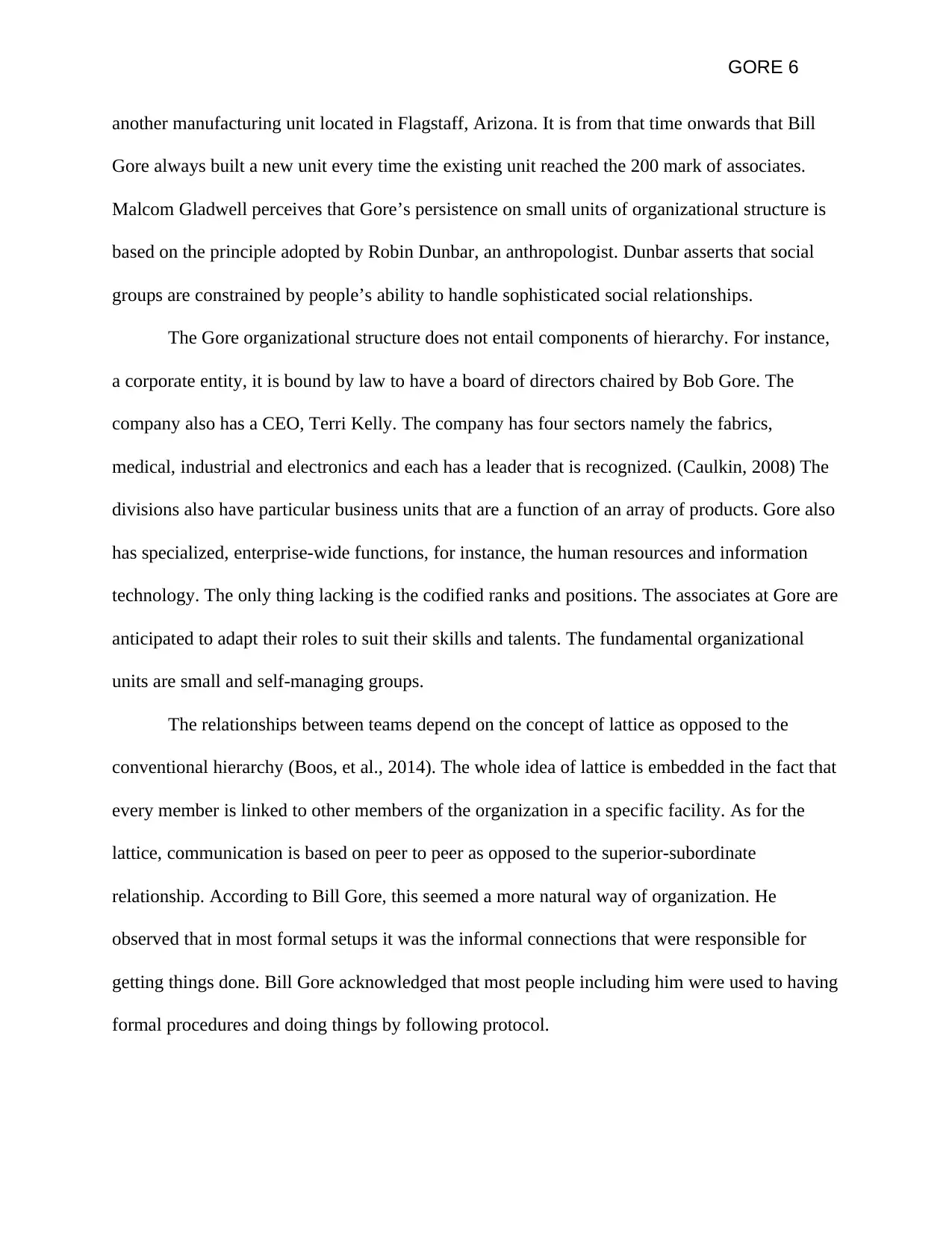
GORE 6
another manufacturing unit located in Flagstaff, Arizona. It is from that time onwards that Bill
Gore always built a new unit every time the existing unit reached the 200 mark of associates.
Malcom Gladwell perceives that Gore’s persistence on small units of organizational structure is
based on the principle adopted by Robin Dunbar, an anthropologist. Dunbar asserts that social
groups are constrained by people’s ability to handle sophisticated social relationships.
The Gore organizational structure does not entail components of hierarchy. For instance,
a corporate entity, it is bound by law to have a board of directors chaired by Bob Gore. The
company also has a CEO, Terri Kelly. The company has four sectors namely the fabrics,
medical, industrial and electronics and each has a leader that is recognized. (Caulkin, 2008) The
divisions also have particular business units that are a function of an array of products. Gore also
has specialized, enterprise-wide functions, for instance, the human resources and information
technology. The only thing lacking is the codified ranks and positions. The associates at Gore are
anticipated to adapt their roles to suit their skills and talents. The fundamental organizational
units are small and self-managing groups.
The relationships between teams depend on the concept of lattice as opposed to the
conventional hierarchy (Boos, et al., 2014). The whole idea of lattice is embedded in the fact that
every member is linked to other members of the organization in a specific facility. As for the
lattice, communication is based on peer to peer as opposed to the superior-subordinate
relationship. According to Bill Gore, this seemed a more natural way of organization. He
observed that in most formal setups it was the informal connections that were responsible for
getting things done. Bill Gore acknowledged that most people including him were used to having
formal procedures and doing things by following protocol.
another manufacturing unit located in Flagstaff, Arizona. It is from that time onwards that Bill
Gore always built a new unit every time the existing unit reached the 200 mark of associates.
Malcom Gladwell perceives that Gore’s persistence on small units of organizational structure is
based on the principle adopted by Robin Dunbar, an anthropologist. Dunbar asserts that social
groups are constrained by people’s ability to handle sophisticated social relationships.
The Gore organizational structure does not entail components of hierarchy. For instance,
a corporate entity, it is bound by law to have a board of directors chaired by Bob Gore. The
company also has a CEO, Terri Kelly. The company has four sectors namely the fabrics,
medical, industrial and electronics and each has a leader that is recognized. (Caulkin, 2008) The
divisions also have particular business units that are a function of an array of products. Gore also
has specialized, enterprise-wide functions, for instance, the human resources and information
technology. The only thing lacking is the codified ranks and positions. The associates at Gore are
anticipated to adapt their roles to suit their skills and talents. The fundamental organizational
units are small and self-managing groups.
The relationships between teams depend on the concept of lattice as opposed to the
conventional hierarchy (Boos, et al., 2014). The whole idea of lattice is embedded in the fact that
every member is linked to other members of the organization in a specific facility. As for the
lattice, communication is based on peer to peer as opposed to the superior-subordinate
relationship. According to Bill Gore, this seemed a more natural way of organization. He
observed that in most formal setups it was the informal connections that were responsible for
getting things done. Bill Gore acknowledged that most people including him were used to having
formal procedures and doing things by following protocol.
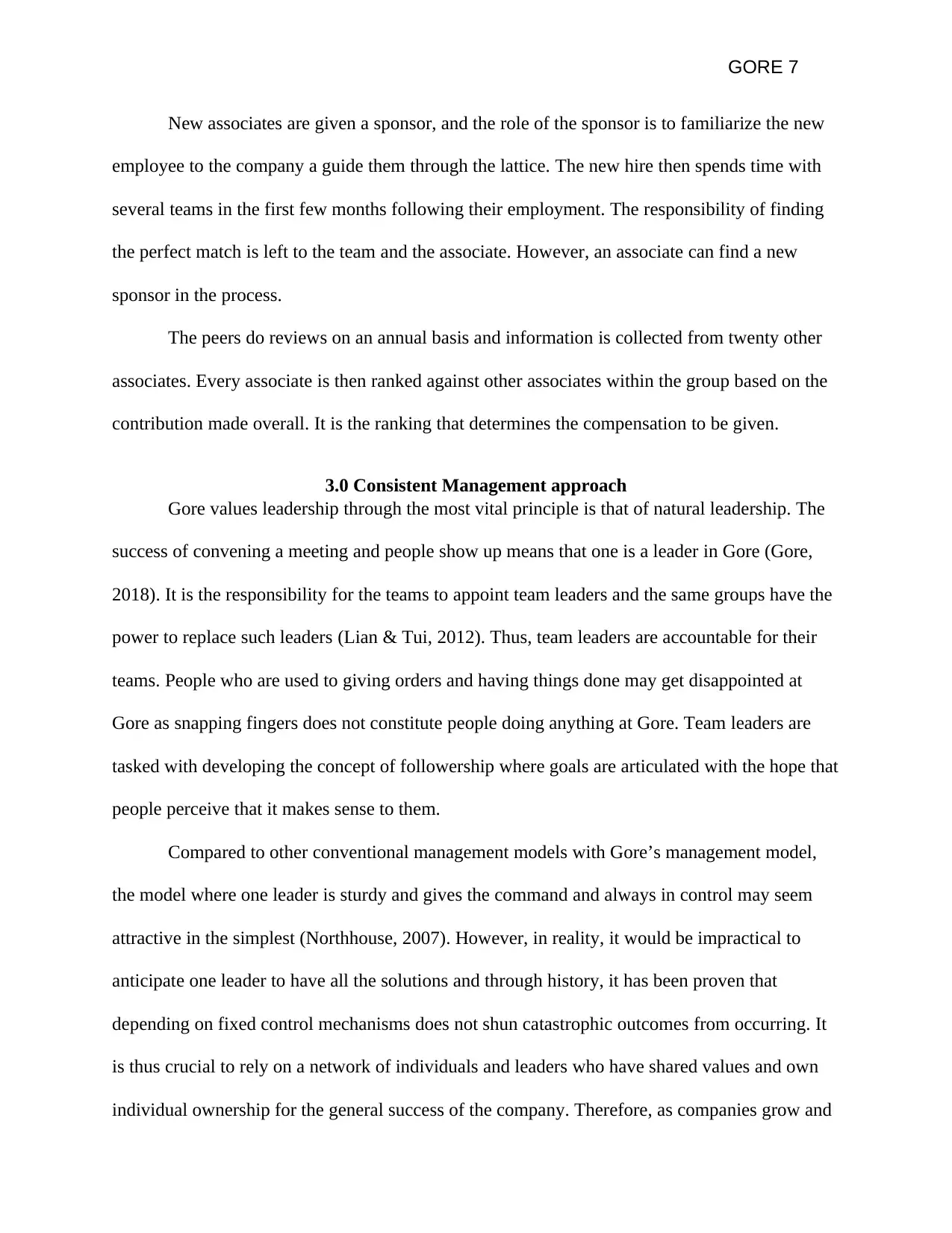
GORE 7
New associates are given a sponsor, and the role of the sponsor is to familiarize the new
employee to the company a guide them through the lattice. The new hire then spends time with
several teams in the first few months following their employment. The responsibility of finding
the perfect match is left to the team and the associate. However, an associate can find a new
sponsor in the process.
The peers do reviews on an annual basis and information is collected from twenty other
associates. Every associate is then ranked against other associates within the group based on the
contribution made overall. It is the ranking that determines the compensation to be given.
3.0 Consistent Management approach
Gore values leadership through the most vital principle is that of natural leadership. The
success of convening a meeting and people show up means that one is a leader in Gore (Gore,
2018). It is the responsibility for the teams to appoint team leaders and the same groups have the
power to replace such leaders (Lian & Tui, 2012). Thus, team leaders are accountable for their
teams. People who are used to giving orders and having things done may get disappointed at
Gore as snapping fingers does not constitute people doing anything at Gore. Team leaders are
tasked with developing the concept of followership where goals are articulated with the hope that
people perceive that it makes sense to them.
Compared to other conventional management models with Gore’s management model,
the model where one leader is sturdy and gives the command and always in control may seem
attractive in the simplest (Northhouse, 2007). However, in reality, it would be impractical to
anticipate one leader to have all the solutions and through history, it has been proven that
depending on fixed control mechanisms does not shun catastrophic outcomes from occurring. It
is thus crucial to rely on a network of individuals and leaders who have shared values and own
individual ownership for the general success of the company. Therefore, as companies grow and
New associates are given a sponsor, and the role of the sponsor is to familiarize the new
employee to the company a guide them through the lattice. The new hire then spends time with
several teams in the first few months following their employment. The responsibility of finding
the perfect match is left to the team and the associate. However, an associate can find a new
sponsor in the process.
The peers do reviews on an annual basis and information is collected from twenty other
associates. Every associate is then ranked against other associates within the group based on the
contribution made overall. It is the ranking that determines the compensation to be given.
3.0 Consistent Management approach
Gore values leadership through the most vital principle is that of natural leadership. The
success of convening a meeting and people show up means that one is a leader in Gore (Gore,
2018). It is the responsibility for the teams to appoint team leaders and the same groups have the
power to replace such leaders (Lian & Tui, 2012). Thus, team leaders are accountable for their
teams. People who are used to giving orders and having things done may get disappointed at
Gore as snapping fingers does not constitute people doing anything at Gore. Team leaders are
tasked with developing the concept of followership where goals are articulated with the hope that
people perceive that it makes sense to them.
Compared to other conventional management models with Gore’s management model,
the model where one leader is sturdy and gives the command and always in control may seem
attractive in the simplest (Northhouse, 2007). However, in reality, it would be impractical to
anticipate one leader to have all the solutions and through history, it has been proven that
depending on fixed control mechanisms does not shun catastrophic outcomes from occurring. It
is thus crucial to rely on a network of individuals and leaders who have shared values and own
individual ownership for the general success of the company. Therefore, as companies grow and
Paraphrase This Document
Need a fresh take? Get an instant paraphrase of this document with our AI Paraphraser
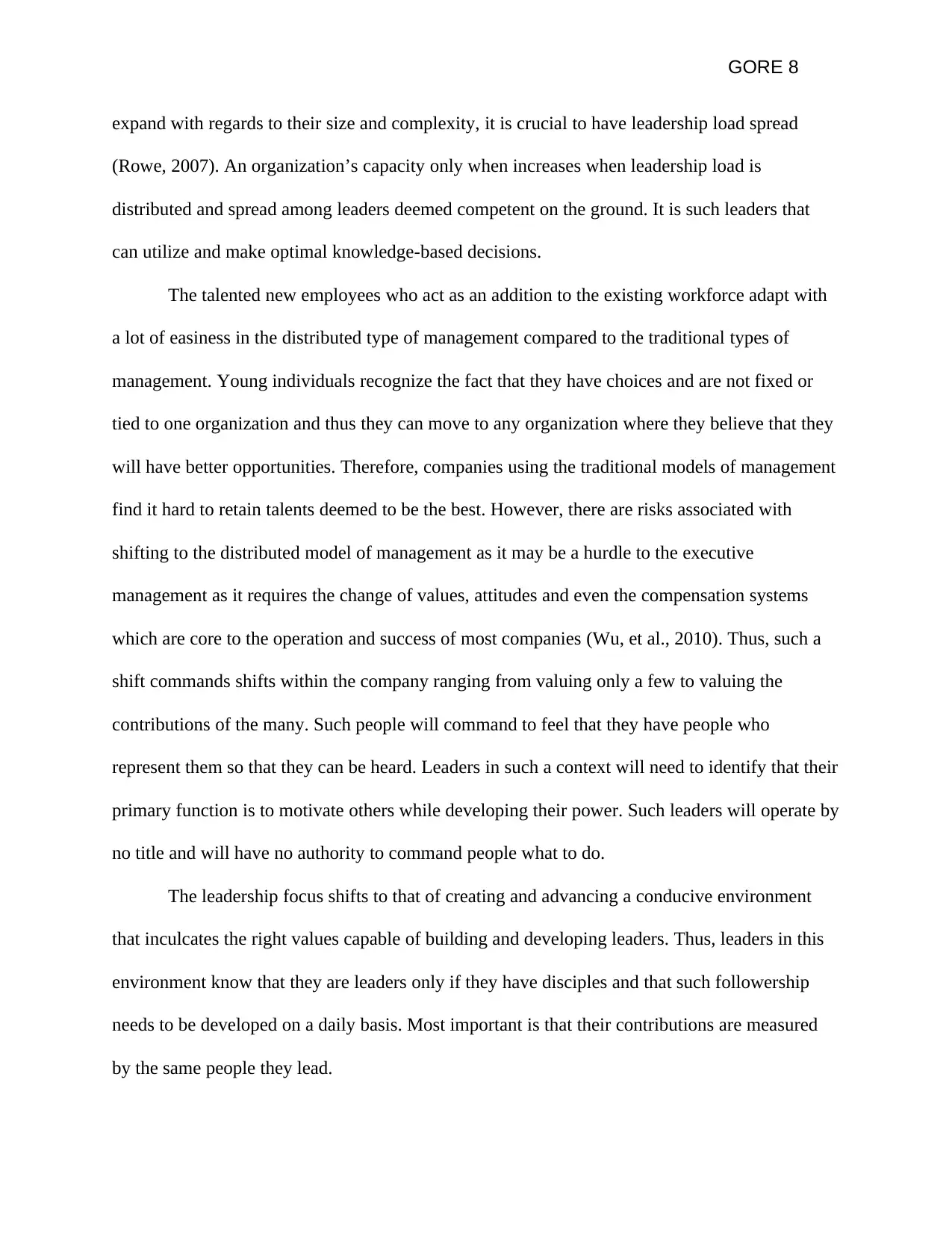
GORE 8
expand with regards to their size and complexity, it is crucial to have leadership load spread
(Rowe, 2007). An organization’s capacity only when increases when leadership load is
distributed and spread among leaders deemed competent on the ground. It is such leaders that
can utilize and make optimal knowledge-based decisions.
The talented new employees who act as an addition to the existing workforce adapt with
a lot of easiness in the distributed type of management compared to the traditional types of
management. Young individuals recognize the fact that they have choices and are not fixed or
tied to one organization and thus they can move to any organization where they believe that they
will have better opportunities. Therefore, companies using the traditional models of management
find it hard to retain talents deemed to be the best. However, there are risks associated with
shifting to the distributed model of management as it may be a hurdle to the executive
management as it requires the change of values, attitudes and even the compensation systems
which are core to the operation and success of most companies (Wu, et al., 2010). Thus, such a
shift commands shifts within the company ranging from valuing only a few to valuing the
contributions of the many. Such people will command to feel that they have people who
represent them so that they can be heard. Leaders in such a context will need to identify that their
primary function is to motivate others while developing their power. Such leaders will operate by
no title and will have no authority to command people what to do.
The leadership focus shifts to that of creating and advancing a conducive environment
that inculcates the right values capable of building and developing leaders. Thus, leaders in this
environment know that they are leaders only if they have disciples and that such followership
needs to be developed on a daily basis. Most important is that their contributions are measured
by the same people they lead.
expand with regards to their size and complexity, it is crucial to have leadership load spread
(Rowe, 2007). An organization’s capacity only when increases when leadership load is
distributed and spread among leaders deemed competent on the ground. It is such leaders that
can utilize and make optimal knowledge-based decisions.
The talented new employees who act as an addition to the existing workforce adapt with
a lot of easiness in the distributed type of management compared to the traditional types of
management. Young individuals recognize the fact that they have choices and are not fixed or
tied to one organization and thus they can move to any organization where they believe that they
will have better opportunities. Therefore, companies using the traditional models of management
find it hard to retain talents deemed to be the best. However, there are risks associated with
shifting to the distributed model of management as it may be a hurdle to the executive
management as it requires the change of values, attitudes and even the compensation systems
which are core to the operation and success of most companies (Wu, et al., 2010). Thus, such a
shift commands shifts within the company ranging from valuing only a few to valuing the
contributions of the many. Such people will command to feel that they have people who
represent them so that they can be heard. Leaders in such a context will need to identify that their
primary function is to motivate others while developing their power. Such leaders will operate by
no title and will have no authority to command people what to do.
The leadership focus shifts to that of creating and advancing a conducive environment
that inculcates the right values capable of building and developing leaders. Thus, leaders in this
environment know that they are leaders only if they have disciples and that such followership
needs to be developed on a daily basis. Most important is that their contributions are measured
by the same people they lead.
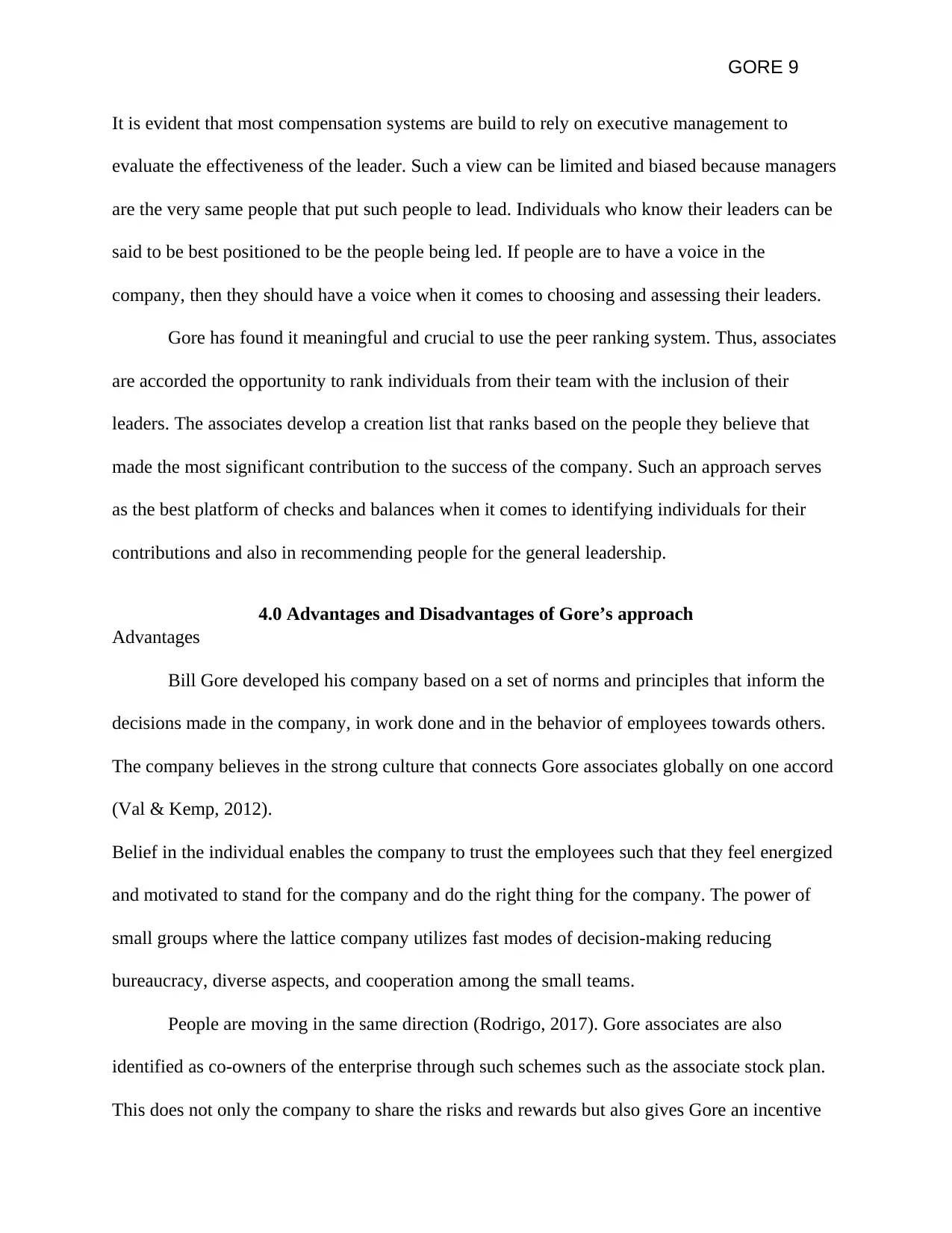
GORE 9
It is evident that most compensation systems are build to rely on executive management to
evaluate the effectiveness of the leader. Such a view can be limited and biased because managers
are the very same people that put such people to lead. Individuals who know their leaders can be
said to be best positioned to be the people being led. If people are to have a voice in the
company, then they should have a voice when it comes to choosing and assessing their leaders.
Gore has found it meaningful and crucial to use the peer ranking system. Thus, associates
are accorded the opportunity to rank individuals from their team with the inclusion of their
leaders. The associates develop a creation list that ranks based on the people they believe that
made the most significant contribution to the success of the company. Such an approach serves
as the best platform of checks and balances when it comes to identifying individuals for their
contributions and also in recommending people for the general leadership.
4.0 Advantages and Disadvantages of Gore’s approach
Advantages
Bill Gore developed his company based on a set of norms and principles that inform the
decisions made in the company, in work done and in the behavior of employees towards others.
The company believes in the strong culture that connects Gore associates globally on one accord
(Val & Kemp, 2012).
Belief in the individual enables the company to trust the employees such that they feel energized
and motivated to stand for the company and do the right thing for the company. The power of
small groups where the lattice company utilizes fast modes of decision-making reducing
bureaucracy, diverse aspects, and cooperation among the small teams.
People are moving in the same direction (Rodrigo, 2017). Gore associates are also
identified as co-owners of the enterprise through such schemes such as the associate stock plan.
This does not only the company to share the risks and rewards but also gives Gore an incentive
It is evident that most compensation systems are build to rely on executive management to
evaluate the effectiveness of the leader. Such a view can be limited and biased because managers
are the very same people that put such people to lead. Individuals who know their leaders can be
said to be best positioned to be the people being led. If people are to have a voice in the
company, then they should have a voice when it comes to choosing and assessing their leaders.
Gore has found it meaningful and crucial to use the peer ranking system. Thus, associates
are accorded the opportunity to rank individuals from their team with the inclusion of their
leaders. The associates develop a creation list that ranks based on the people they believe that
made the most significant contribution to the success of the company. Such an approach serves
as the best platform of checks and balances when it comes to identifying individuals for their
contributions and also in recommending people for the general leadership.
4.0 Advantages and Disadvantages of Gore’s approach
Advantages
Bill Gore developed his company based on a set of norms and principles that inform the
decisions made in the company, in work done and in the behavior of employees towards others.
The company believes in the strong culture that connects Gore associates globally on one accord
(Val & Kemp, 2012).
Belief in the individual enables the company to trust the employees such that they feel energized
and motivated to stand for the company and do the right thing for the company. The power of
small groups where the lattice company utilizes fast modes of decision-making reducing
bureaucracy, diverse aspects, and cooperation among the small teams.
People are moving in the same direction (Rodrigo, 2017). Gore associates are also
identified as co-owners of the enterprise through such schemes such as the associate stock plan.
This does not only the company to share the risks and rewards but also gives Gore an incentive
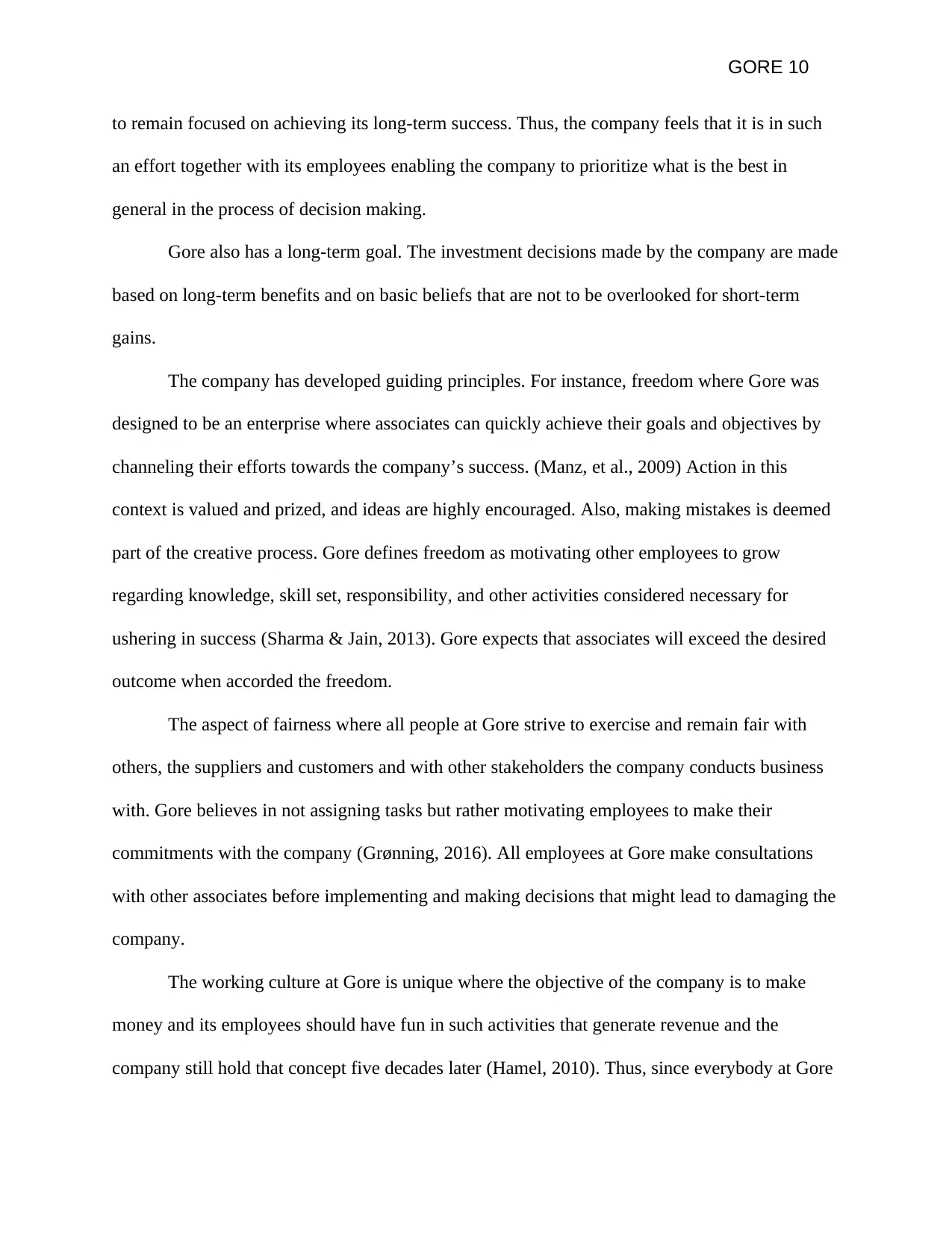
GORE 10
to remain focused on achieving its long-term success. Thus, the company feels that it is in such
an effort together with its employees enabling the company to prioritize what is the best in
general in the process of decision making.
Gore also has a long-term goal. The investment decisions made by the company are made
based on long-term benefits and on basic beliefs that are not to be overlooked for short-term
gains.
The company has developed guiding principles. For instance, freedom where Gore was
designed to be an enterprise where associates can quickly achieve their goals and objectives by
channeling their efforts towards the company’s success. (Manz, et al., 2009) Action in this
context is valued and prized, and ideas are highly encouraged. Also, making mistakes is deemed
part of the creative process. Gore defines freedom as motivating other employees to grow
regarding knowledge, skill set, responsibility, and other activities considered necessary for
ushering in success (Sharma & Jain, 2013). Gore expects that associates will exceed the desired
outcome when accorded the freedom.
The aspect of fairness where all people at Gore strive to exercise and remain fair with
others, the suppliers and customers and with other stakeholders the company conducts business
with. Gore believes in not assigning tasks but rather motivating employees to make their
commitments with the company (Grønning, 2016). All employees at Gore make consultations
with other associates before implementing and making decisions that might lead to damaging the
company.
The working culture at Gore is unique where the objective of the company is to make
money and its employees should have fun in such activities that generate revenue and the
company still hold that concept five decades later (Hamel, 2010). Thus, since everybody at Gore
to remain focused on achieving its long-term success. Thus, the company feels that it is in such
an effort together with its employees enabling the company to prioritize what is the best in
general in the process of decision making.
Gore also has a long-term goal. The investment decisions made by the company are made
based on long-term benefits and on basic beliefs that are not to be overlooked for short-term
gains.
The company has developed guiding principles. For instance, freedom where Gore was
designed to be an enterprise where associates can quickly achieve their goals and objectives by
channeling their efforts towards the company’s success. (Manz, et al., 2009) Action in this
context is valued and prized, and ideas are highly encouraged. Also, making mistakes is deemed
part of the creative process. Gore defines freedom as motivating other employees to grow
regarding knowledge, skill set, responsibility, and other activities considered necessary for
ushering in success (Sharma & Jain, 2013). Gore expects that associates will exceed the desired
outcome when accorded the freedom.
The aspect of fairness where all people at Gore strive to exercise and remain fair with
others, the suppliers and customers and with other stakeholders the company conducts business
with. Gore believes in not assigning tasks but rather motivating employees to make their
commitments with the company (Grønning, 2016). All employees at Gore make consultations
with other associates before implementing and making decisions that might lead to damaging the
company.
The working culture at Gore is unique where the objective of the company is to make
money and its employees should have fun in such activities that generate revenue and the
company still hold that concept five decades later (Hamel, 2010). Thus, since everybody at Gore
Secure Best Marks with AI Grader
Need help grading? Try our AI Grader for instant feedback on your assignments.
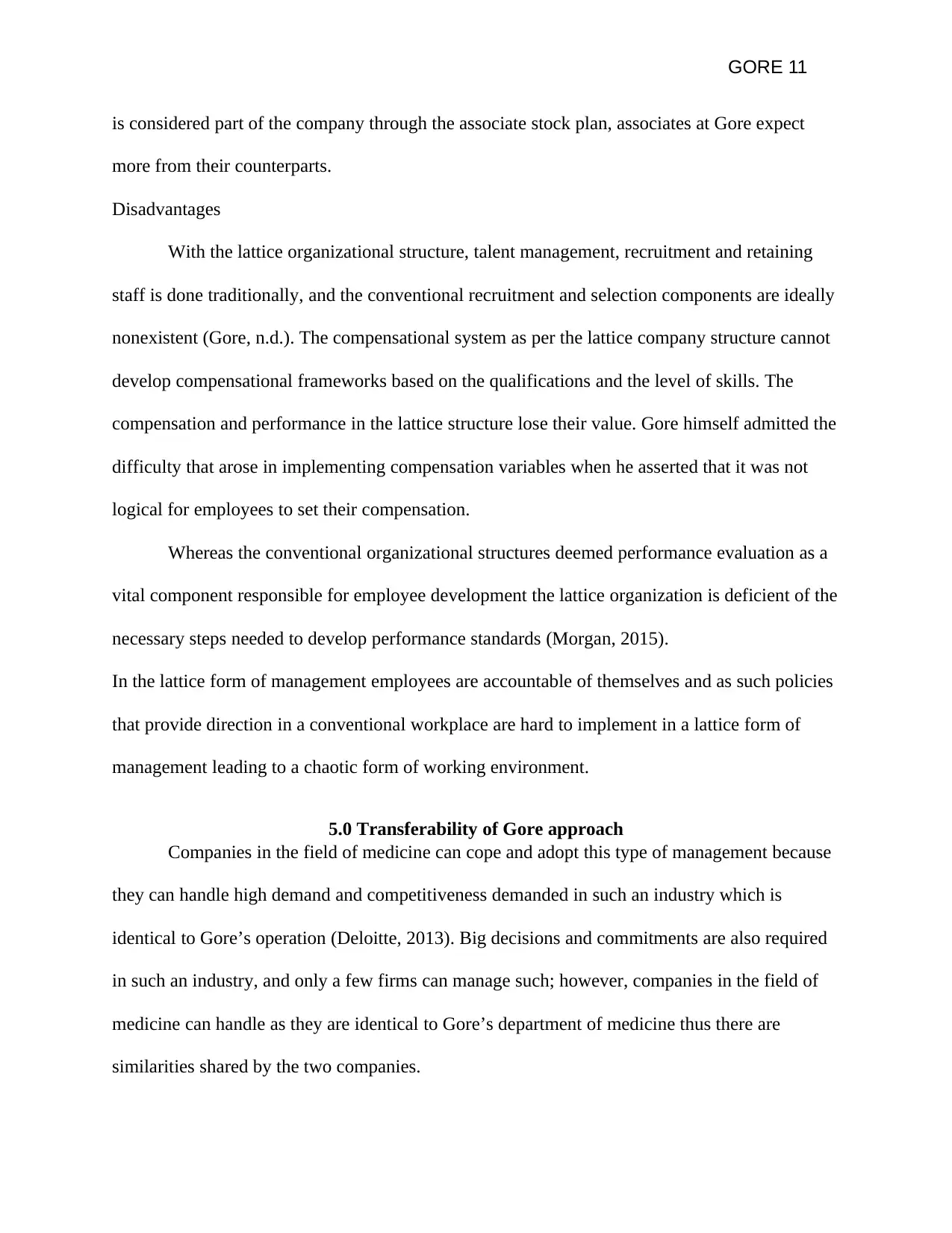
GORE 11
is considered part of the company through the associate stock plan, associates at Gore expect
more from their counterparts.
Disadvantages
With the lattice organizational structure, talent management, recruitment and retaining
staff is done traditionally, and the conventional recruitment and selection components are ideally
nonexistent (Gore, n.d.). The compensational system as per the lattice company structure cannot
develop compensational frameworks based on the qualifications and the level of skills. The
compensation and performance in the lattice structure lose their value. Gore himself admitted the
difficulty that arose in implementing compensation variables when he asserted that it was not
logical for employees to set their compensation.
Whereas the conventional organizational structures deemed performance evaluation as a
vital component responsible for employee development the lattice organization is deficient of the
necessary steps needed to develop performance standards (Morgan, 2015).
In the lattice form of management employees are accountable of themselves and as such policies
that provide direction in a conventional workplace are hard to implement in a lattice form of
management leading to a chaotic form of working environment.
5.0 Transferability of Gore approach
Companies in the field of medicine can cope and adopt this type of management because
they can handle high demand and competitiveness demanded in such an industry which is
identical to Gore’s operation (Deloitte, 2013). Big decisions and commitments are also required
in such an industry, and only a few firms can manage such; however, companies in the field of
medicine can handle as they are identical to Gore’s department of medicine thus there are
similarities shared by the two companies.
is considered part of the company through the associate stock plan, associates at Gore expect
more from their counterparts.
Disadvantages
With the lattice organizational structure, talent management, recruitment and retaining
staff is done traditionally, and the conventional recruitment and selection components are ideally
nonexistent (Gore, n.d.). The compensational system as per the lattice company structure cannot
develop compensational frameworks based on the qualifications and the level of skills. The
compensation and performance in the lattice structure lose their value. Gore himself admitted the
difficulty that arose in implementing compensation variables when he asserted that it was not
logical for employees to set their compensation.
Whereas the conventional organizational structures deemed performance evaluation as a
vital component responsible for employee development the lattice organization is deficient of the
necessary steps needed to develop performance standards (Morgan, 2015).
In the lattice form of management employees are accountable of themselves and as such policies
that provide direction in a conventional workplace are hard to implement in a lattice form of
management leading to a chaotic form of working environment.
5.0 Transferability of Gore approach
Companies in the field of medicine can cope and adopt this type of management because
they can handle high demand and competitiveness demanded in such an industry which is
identical to Gore’s operation (Deloitte, 2013). Big decisions and commitments are also required
in such an industry, and only a few firms can manage such; however, companies in the field of
medicine can handle as they are identical to Gore’s department of medicine thus there are
similarities shared by the two companies.
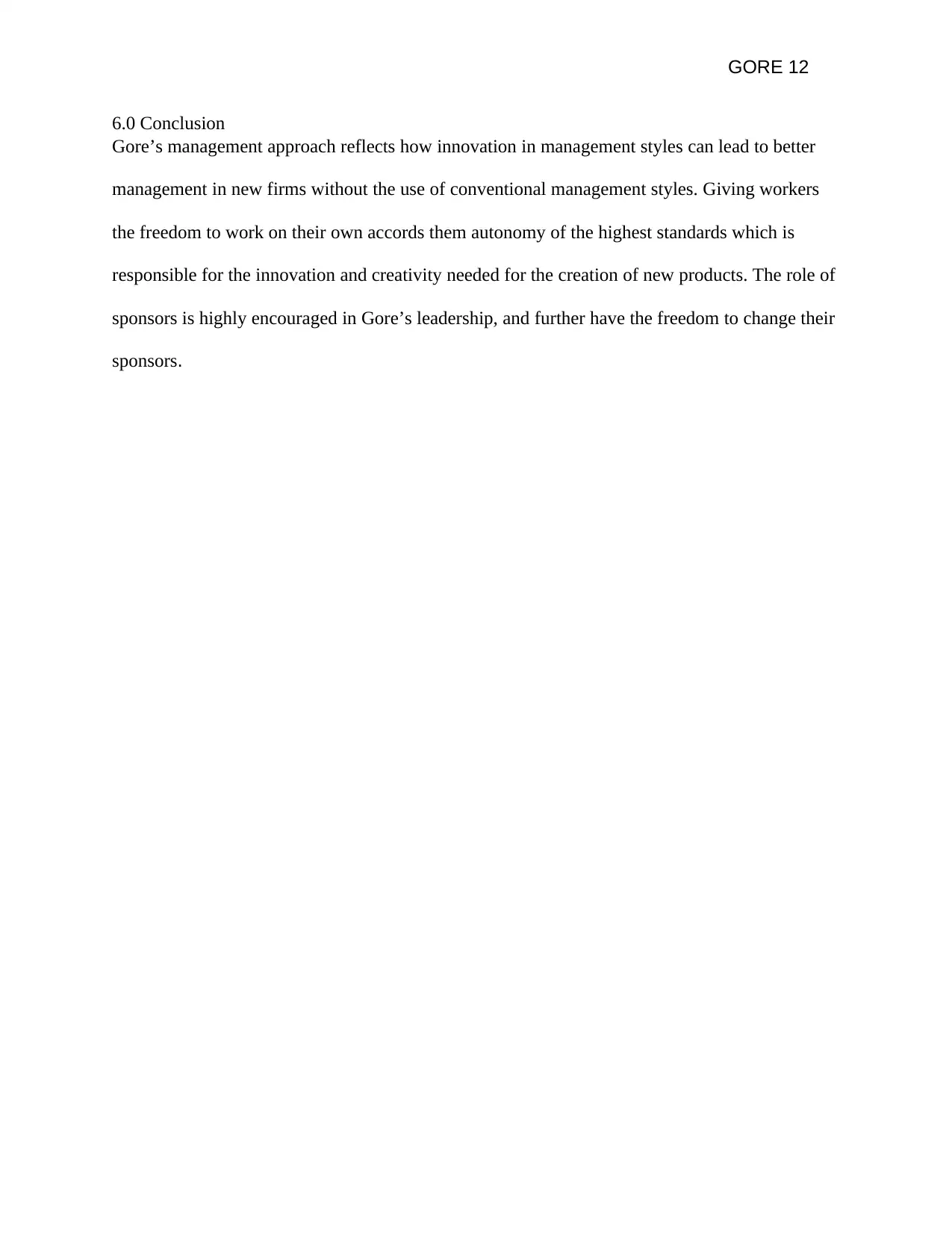
GORE 12
6.0 Conclusion
Gore’s management approach reflects how innovation in management styles can lead to better
management in new firms without the use of conventional management styles. Giving workers
the freedom to work on their own accords them autonomy of the highest standards which is
responsible for the innovation and creativity needed for the creation of new products. The role of
sponsors is highly encouraged in Gore’s leadership, and further have the freedom to change their
sponsors.
6.0 Conclusion
Gore’s management approach reflects how innovation in management styles can lead to better
management in new firms without the use of conventional management styles. Giving workers
the freedom to work on their own accords them autonomy of the highest standards which is
responsible for the innovation and creativity needed for the creation of new products. The role of
sponsors is highly encouraged in Gore’s leadership, and further have the freedom to change their
sponsors.
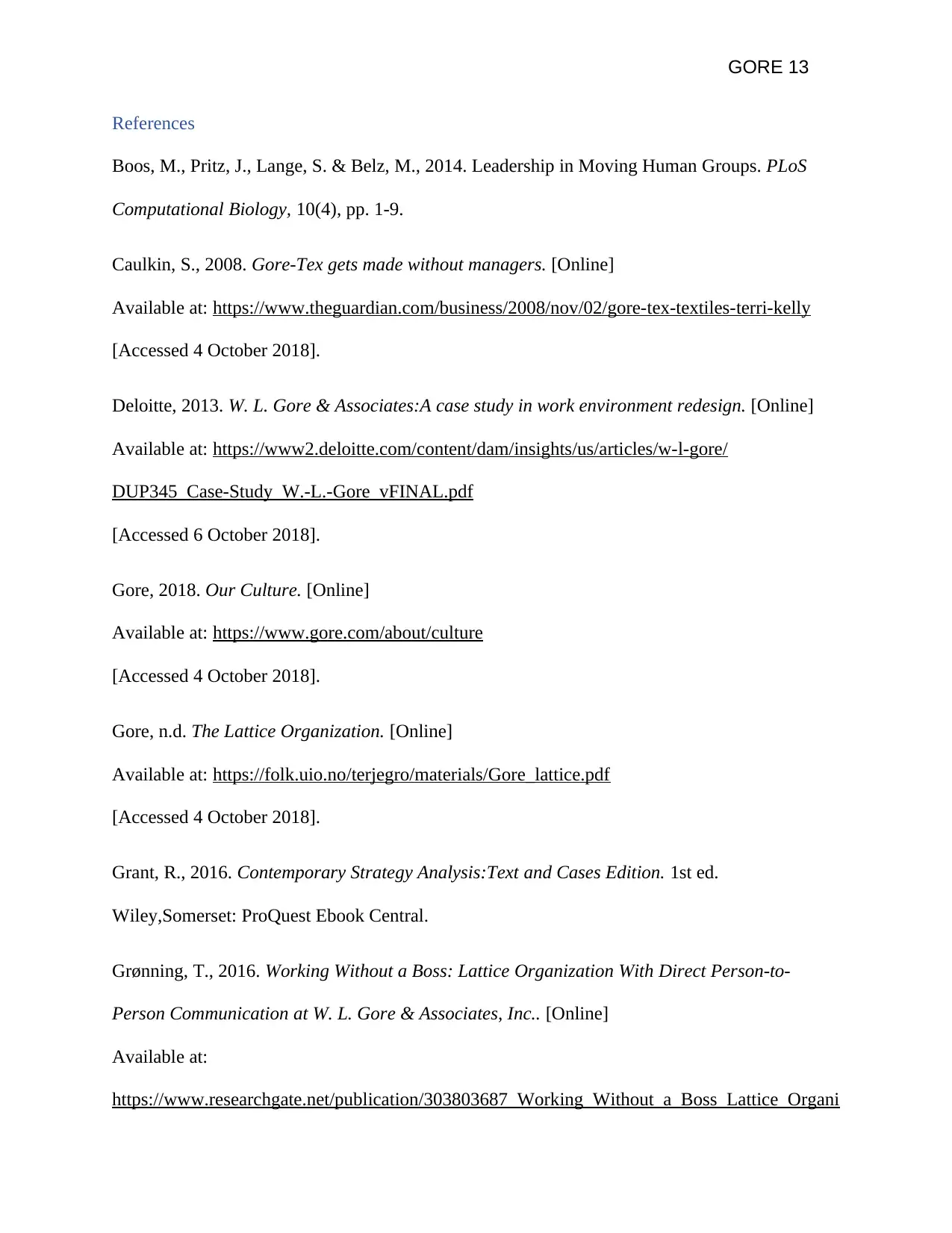
GORE 13
References
Boos, M., Pritz, J., Lange, S. & Belz, M., 2014. Leadership in Moving Human Groups. PLoS
Computational Biology, 10(4), pp. 1-9.
Caulkin, S., 2008. Gore-Tex gets made without managers. [Online]
Available at: https://www.theguardian.com/business/2008/nov/02/gore-tex-textiles-terri-kelly
[Accessed 4 October 2018].
Deloitte, 2013. W. L. Gore & Associates:A case study in work environment redesign. [Online]
Available at: https://www2.deloitte.com/content/dam/insights/us/articles/w-l-gore/
DUP345_Case-Study_W.-L.-Gore_vFINAL.pdf
[Accessed 6 October 2018].
Gore, 2018. Our Culture. [Online]
Available at: https://www.gore.com/about/culture
[Accessed 4 October 2018].
Gore, n.d. The Lattice Organization. [Online]
Available at: https://folk.uio.no/terjegro/materials/Gore_lattice.pdf
[Accessed 4 October 2018].
Grant, R., 2016. Contemporary Strategy Analysis:Text and Cases Edition. 1st ed.
Wiley,Somerset: ProQuest Ebook Central.
Grønning, T., 2016. Working Without a Boss: Lattice Organization With Direct Person-to-
Person Communication at W. L. Gore & Associates, Inc.. [Online]
Available at:
https://www.researchgate.net/publication/303803687_Working_Without_a_Boss_Lattice_Organi
References
Boos, M., Pritz, J., Lange, S. & Belz, M., 2014. Leadership in Moving Human Groups. PLoS
Computational Biology, 10(4), pp. 1-9.
Caulkin, S., 2008. Gore-Tex gets made without managers. [Online]
Available at: https://www.theguardian.com/business/2008/nov/02/gore-tex-textiles-terri-kelly
[Accessed 4 October 2018].
Deloitte, 2013. W. L. Gore & Associates:A case study in work environment redesign. [Online]
Available at: https://www2.deloitte.com/content/dam/insights/us/articles/w-l-gore/
DUP345_Case-Study_W.-L.-Gore_vFINAL.pdf
[Accessed 6 October 2018].
Gore, 2018. Our Culture. [Online]
Available at: https://www.gore.com/about/culture
[Accessed 4 October 2018].
Gore, n.d. The Lattice Organization. [Online]
Available at: https://folk.uio.no/terjegro/materials/Gore_lattice.pdf
[Accessed 4 October 2018].
Grant, R., 2016. Contemporary Strategy Analysis:Text and Cases Edition. 1st ed.
Wiley,Somerset: ProQuest Ebook Central.
Grønning, T., 2016. Working Without a Boss: Lattice Organization With Direct Person-to-
Person Communication at W. L. Gore & Associates, Inc.. [Online]
Available at:
https://www.researchgate.net/publication/303803687_Working_Without_a_Boss_Lattice_Organi
Paraphrase This Document
Need a fresh take? Get an instant paraphrase of this document with our AI Paraphraser
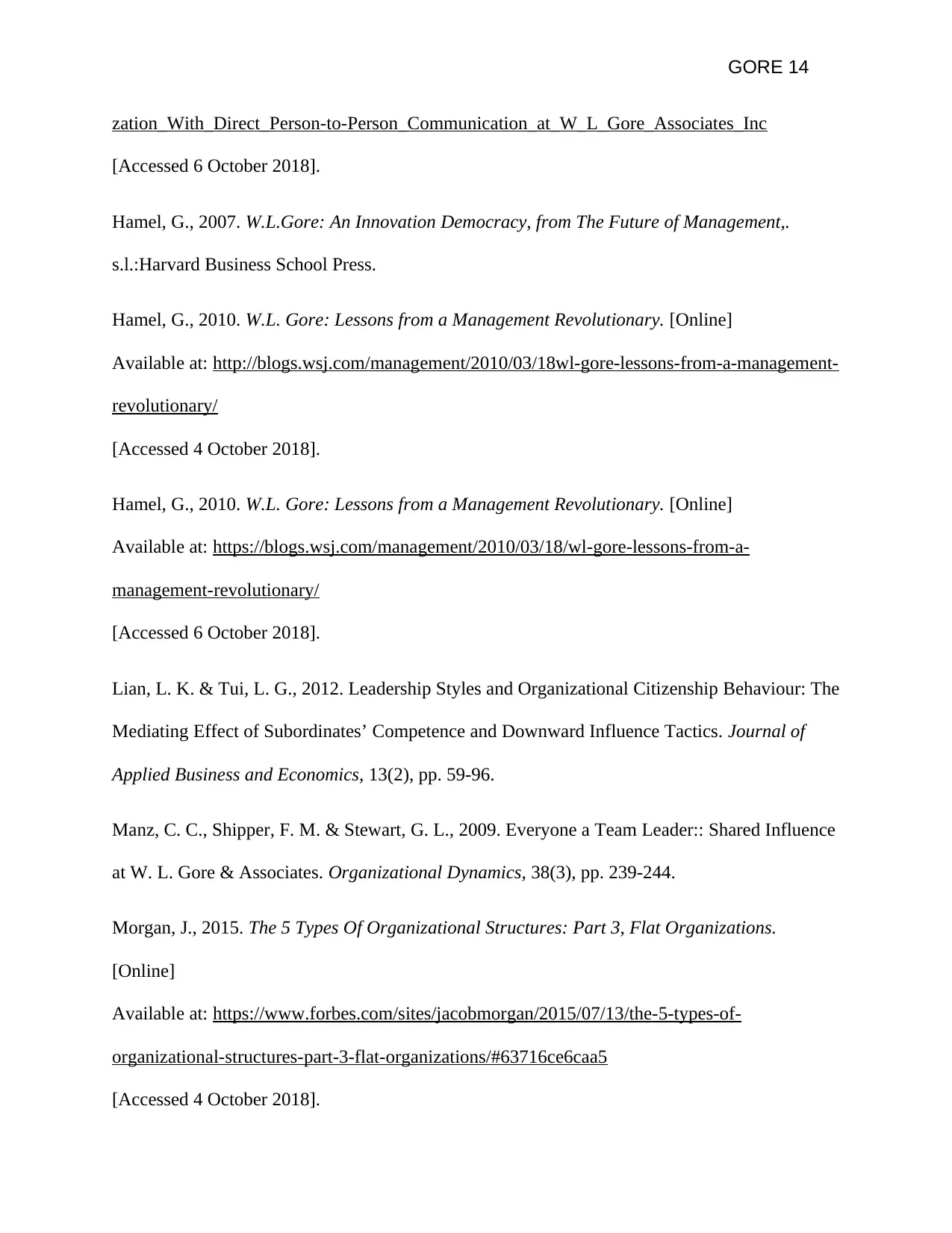
GORE 14
zation_With_Direct_Person-to-Person_Communication_at_W_L_Gore_Associates_Inc
[Accessed 6 October 2018].
Hamel, G., 2007. W.L.Gore: An Innovation Democracy, from The Future of Management,.
s.l.:Harvard Business School Press.
Hamel, G., 2010. W.L. Gore: Lessons from a Management Revolutionary. [Online]
Available at: http://blogs.wsj.com/management/2010/03/18wl-gore-lessons-from-a-management-
revolutionary/
[Accessed 4 October 2018].
Hamel, G., 2010. W.L. Gore: Lessons from a Management Revolutionary. [Online]
Available at: https://blogs.wsj.com/management/2010/03/18/wl-gore-lessons-from-a-
management-revolutionary/
[Accessed 6 October 2018].
Lian, L. K. & Tui, L. G., 2012. Leadership Styles and Organizational Citizenship Behaviour: The
Mediating Effect of Subordinates’ Competence and Downward Influence Tactics. Journal of
Applied Business and Economics, 13(2), pp. 59-96.
Manz, C. C., Shipper, F. M. & Stewart, G. L., 2009. Everyone a Team Leader:: Shared Influence
at W. L. Gore & Associates. Organizational Dynamics, 38(3), pp. 239-244.
Morgan, J., 2015. The 5 Types Of Organizational Structures: Part 3, Flat Organizations.
[Online]
Available at: https://www.forbes.com/sites/jacobmorgan/2015/07/13/the-5-types-of-
organizational-structures-part-3-flat-organizations/#63716ce6caa5
[Accessed 4 October 2018].
zation_With_Direct_Person-to-Person_Communication_at_W_L_Gore_Associates_Inc
[Accessed 6 October 2018].
Hamel, G., 2007. W.L.Gore: An Innovation Democracy, from The Future of Management,.
s.l.:Harvard Business School Press.
Hamel, G., 2010. W.L. Gore: Lessons from a Management Revolutionary. [Online]
Available at: http://blogs.wsj.com/management/2010/03/18wl-gore-lessons-from-a-management-
revolutionary/
[Accessed 4 October 2018].
Hamel, G., 2010. W.L. Gore: Lessons from a Management Revolutionary. [Online]
Available at: https://blogs.wsj.com/management/2010/03/18/wl-gore-lessons-from-a-
management-revolutionary/
[Accessed 6 October 2018].
Lian, L. K. & Tui, L. G., 2012. Leadership Styles and Organizational Citizenship Behaviour: The
Mediating Effect of Subordinates’ Competence and Downward Influence Tactics. Journal of
Applied Business and Economics, 13(2), pp. 59-96.
Manz, C. C., Shipper, F. M. & Stewart, G. L., 2009. Everyone a Team Leader:: Shared Influence
at W. L. Gore & Associates. Organizational Dynamics, 38(3), pp. 239-244.
Morgan, J., 2015. The 5 Types Of Organizational Structures: Part 3, Flat Organizations.
[Online]
Available at: https://www.forbes.com/sites/jacobmorgan/2015/07/13/the-5-types-of-
organizational-structures-part-3-flat-organizations/#63716ce6caa5
[Accessed 4 October 2018].
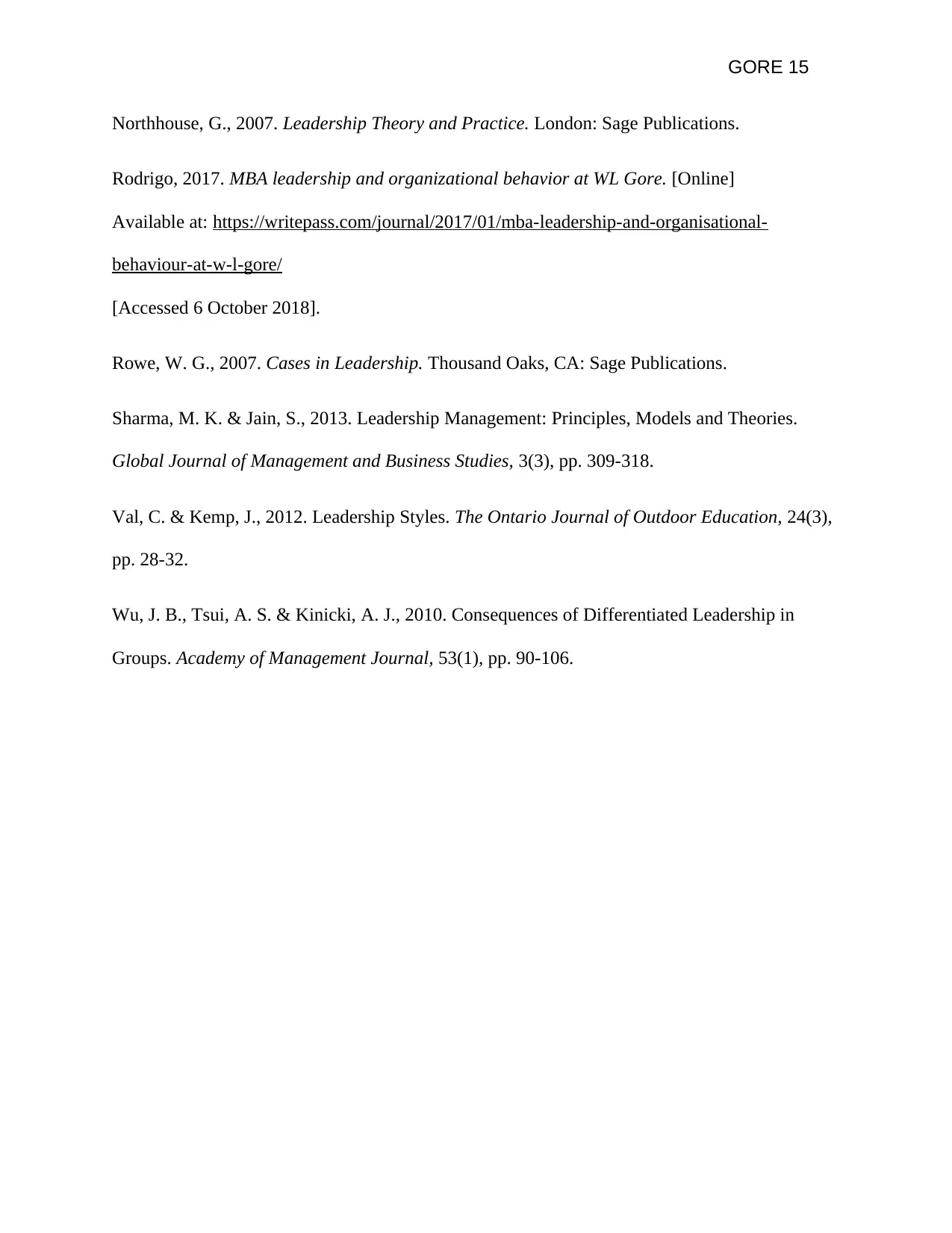
GORE 15
Northhouse, G., 2007. Leadership Theory and Practice. London: Sage Publications.
Rodrigo, 2017. MBA leadership and organizational behavior at WL Gore. [Online]
Available at: https://writepass.com/journal/2017/01/mba-leadership-and-organisational-
behaviour-at-w-l-gore/
[Accessed 6 October 2018].
Rowe, W. G., 2007. Cases in Leadership. Thousand Oaks, CA: Sage Publications.
Sharma, M. K. & Jain, S., 2013. Leadership Management: Principles, Models and Theories.
Global Journal of Management and Business Studies, 3(3), pp. 309-318.
Val, C. & Kemp, J., 2012. Leadership Styles. The Ontario Journal of Outdoor Education, 24(3),
pp. 28-32.
Wu, J. B., Tsui, A. S. & Kinicki, A. J., 2010. Consequences of Differentiated Leadership in
Groups. Academy of Management Journal, 53(1), pp. 90-106.
Northhouse, G., 2007. Leadership Theory and Practice. London: Sage Publications.
Rodrigo, 2017. MBA leadership and organizational behavior at WL Gore. [Online]
Available at: https://writepass.com/journal/2017/01/mba-leadership-and-organisational-
behaviour-at-w-l-gore/
[Accessed 6 October 2018].
Rowe, W. G., 2007. Cases in Leadership. Thousand Oaks, CA: Sage Publications.
Sharma, M. K. & Jain, S., 2013. Leadership Management: Principles, Models and Theories.
Global Journal of Management and Business Studies, 3(3), pp. 309-318.
Val, C. & Kemp, J., 2012. Leadership Styles. The Ontario Journal of Outdoor Education, 24(3),
pp. 28-32.
Wu, J. B., Tsui, A. S. & Kinicki, A. J., 2010. Consequences of Differentiated Leadership in
Groups. Academy of Management Journal, 53(1), pp. 90-106.
1 out of 15
Related Documents
Your All-in-One AI-Powered Toolkit for Academic Success.
+13062052269
info@desklib.com
Available 24*7 on WhatsApp / Email
![[object Object]](/_next/static/media/star-bottom.7253800d.svg)
Unlock your academic potential
© 2024 | Zucol Services PVT LTD | All rights reserved.




